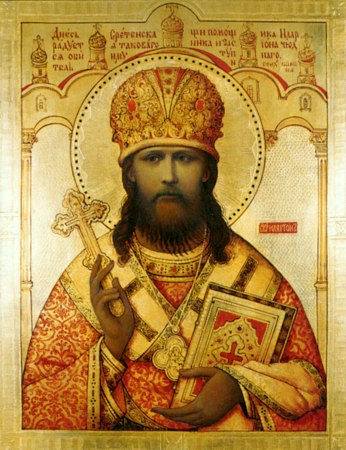Hilarion (Troitsky), archbishop of Verey, hieromartyr
Dates of commemoration
(Church calendar - Jan 23) Synaxis of Holy New Martyrs and Confessors of Russia (movable feast on Sunday, January 25th, if the date falls on a Sunday; in the previous Sunday, when January 25th falls on Monday, Tuesday or Wednesday; or the subsequent Sunday, if January 25th falls on Thursday, Friday or Saturday.
(Church calendar - Apr 27) Day of glorification
(Church calendar - Jun 12) Synaxis of Saints of St. Petersburg (movable feast on the 3rd Sunday of Pentecost)
(Church calendar - Aug 10) Synaxis of New Martyrs and Confessors of Solovki
(Church calendar - Aug 21) Synaxis of all saints of Moscow (movable feast on the Sunday before August 26th)
(Church calendar - Dec 15) Day of repose
Life
The holy New Martyr Archbishop Hilarion (Vladimir Alexievich Troitsky in the world), an outstanding theologian, an eloquent preacher, and a fearless defender of Christ’s holy Church, was born around 1885.
Vladika Hilarion wrote many books and articles on various topics, including “The Unity of the Church.” His Master’s thesis, “An Outline of the History of the Church’s Dogma,” was over five hundred pages long, and was a well-documented analysis of the subject.
During the Council of 1917 he delivered a brilliant address calling for the restoration of the Moscow Patriarchate, which had been dissolved by Tsar Peter I in the eighteenth century. When Saint Tikhon (April 7) was chosen as Patriarch, Saint Hilarion became his fervent supporter.
Saint Hilarion was consecrated as bishop on May 20, 1920, and so the great luminary was placed upon the lampstand (Luke 11:33). From that time, he was to know less than two years of freedom. He spent only six months working with Patriarch Tikhon.
Vladika was arrested and exiled in Archangelsk for a year, then he spent six years (1923-1929) in a labor camp seven versts from Solovki. There at the Filomonov Wharf he and at least two other bishops were employed in catching fish and mending nets. Paraphrasing the hymns of Pentecost, Archbishop Hilarion remarked, “Formerly, the fishermen became theologians. Now the theologians have become fishermen.”
Archbishop Hilarion was one of the most popular inmates of the labor camp. He is remembered as tall, robust, and with brownish hair. Personal possessions meant nothing to him, so he always gave his things away to anyone who asked for them. He never showed annoyance when people disturbed him or insulted him, but remained cheerful.
In the summer of 1925, Vladika was taken from the camp and placed in the Yaroslav prison. There he was treated more leniently, and received certain privileges. For example, he was allowed to receive religious books, and he had pleasant conversations with the warden in his office. Saint Hilarion regarded his time at the Yaroslav Isolated Detention Center as the best part of his imprisonment. The following spring he was back at Solovki.
In 1929 the Communists decided to exile Archbishop Hilarion to Alma-Atu in central Asia. During his trip southward from the far north, Saint Hilarion was robbed and endured many privations. When he arrived in Petrograd, he was ill with typhus, infested with parasites and dressed in rags. When informed that he would have to be shaved, he replied, “You may now do with me whatever you wish.” He wrote from the prison hospital, “My fate will be decided on Saturday, December 15. I doubt I will survive.”
Saint Hilarion died at the age of forty-four in the hospital of a Petrograd prison on December 15, 1929. His body was placed in a coffin hastily made from some boards, and then was released to his family. The once tall and robust Archbishop Hilarion had been transformed by his sufferings into a pitiful white-haired old man. One female relative fainted when she saw the body.
Metropolitan Seraphim (Chichagov) provided a set of white vestments for the late Archbishop. He was also placed in a better coffin.
Metropolitan Seraphim presided at the funeral of Saint Hilarion, assisted by six bishops and several priests. The saint was buried at Novodevichy Monastery.
Source:
https://oca.org/saints/lives/2016/12/15/103704-hieromartyr-hilarion-archbishop-of-vereiya
Holy relic type
unless specified otherwise below, "holy relic" means a fragment of a bone of the saint
1. Holy relic
2. Holy relic
Location of the holy relic in the Cathedral:
1. Icon of hieromartyr Hilarion. South wall of the Altar sacristy
2. Relics cabinet in the Altar sacristy, reliquary #8
Troparion
Тропарь, глас 4:
Святителю Христов Иларионе,/ славо и похвало Церкве Русския,/ разум божественный стяжав,/ пред безбожники Христа дерзновенно исповедал еси,/ Егоже ради страдания претерпевая,/ людем верным возглашал еси:/ без Церкве несть спасения.
Тропaрь, глас 4-й
Воине Христов Иларионе, славо и похвало Церкве Русския, пред гибнущим миром Христа исповедал еси, кровми твоими Церковь утвердися, разум Божественный стяжал еси, людем верным возглашаше: без Церкве несть спасения.
Kontakion
Кондак, глас 2:
Славу мира сего оставив, Христу доблественне последовал еси и, святительское служение восприим, венцем мученичества украсился еси, и ныне, Престолу Божию предстоя, молися, Иларионе, иерарше премудре, спастися душам нашим.
Кондак, глас 6
Иларионе, священномучениче Христов, служителей грядущаго антихриста не убоялся еси, Христа мужески исповедал еси, за Церковь Божию живот твой положи, красо новомученик Российских, Руси Святыя похвало, ты Церкве нашея слава и утверждение.






